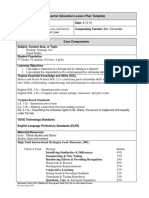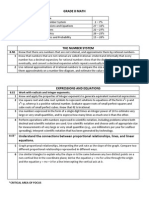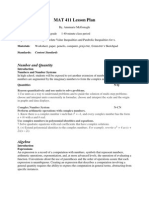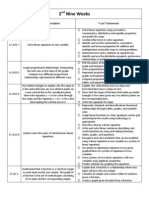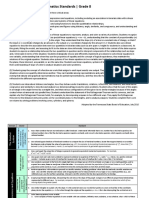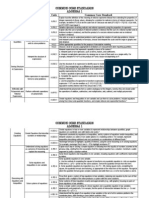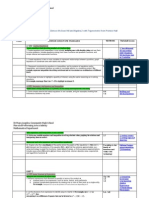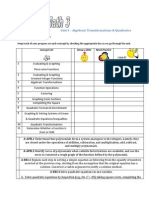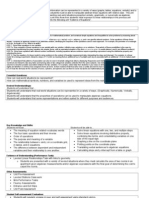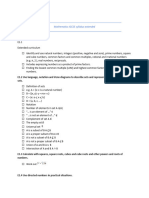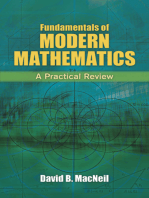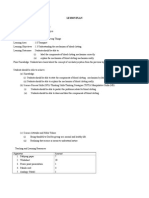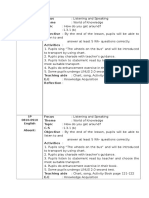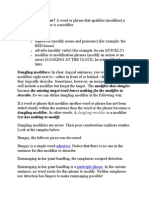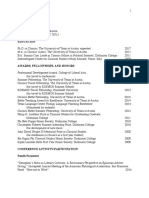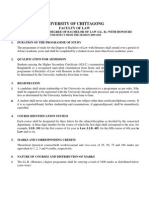0 ratings0% found this document useful (0 votes)
739 viewsOverland Trail
Overland Trail
Uploaded by
api-245623862Copyright:
© All Rights Reserved
Available Formats
Download as DOCX, PDF, TXT or read online from Scribd
Overland Trail
Overland Trail
Uploaded by
api-2456238620 ratings0% found this document useful (0 votes)
739 views8 pagesOriginal Title
overland trail
Copyright
© © All Rights Reserved
Available Formats
DOCX, PDF, TXT or read online from Scribd
Share this document
Did you find this document useful?
Is this content inappropriate?
Copyright:
© All Rights Reserved
Available Formats
Download as DOCX, PDF, TXT or read online from Scribd
Download as docx, pdf, or txt
0 ratings0% found this document useful (0 votes)
739 views8 pagesOverland Trail
Overland Trail
Uploaded by
api-245623862Copyright:
© All Rights Reserved
Available Formats
Download as DOCX, PDF, TXT or read online from Scribd
Download as docx, pdf, or txt
You are on page 1of 8
Sara Brisby
Curriculum Analysis, MIAA 360
The Overland Trail
1. Alignment to standards:
Mathematical Practice Standards
1. Make sense of problems and persevere in
solving them.
-Planning for the Long Journey, pg. 38
-Day 7 Homework, Laced Travelers pg. 51
2. Reason abstractly and quantitatively.
-The General Shoelace, pg. 47-50
-More Fair Shares on Chores, Pgs. 174-175
- Homework 17, The Basic Student Budget,
pgs. 132-133
3. Construct viable arguments and critique the
reasoning of others.
-Homework 3, pg. 28
-POWs give multiple opportunities to
create, present, and defend arguments and
allow students to critique the reasonings of
others.
4. Model with mathematics.
-Ox Expressions, pgs. 64-65
-The Family, pgs. 16-20
-Multiple examples throughout the text
5. Use appropriate tools strategically.
-Sublettes Cutoff, pg. 159
-Calculator In-Out, pgs. 143-145
- Calculator Curve Fitting, pgs. 157- 158
6. Attend to precision
-Homework 13, pg. 99
- Homework 21, pg. 161-162
- Out Numbered, pgs. 95-98
7. Look for and make use of structure
- Fair Share on Chores, pgs. 166-168
- POW 11, High-Low Difference, pgs.
181-182
- Catching Up, pgs. 193-194
8. Look for and express regularity in repeated
reasoning.
-POW 8, pg. 53-56
-Homework 10, pgs. 72-74
-Fair Share for Hired Hands, pg. 169
Grade 8 Standards: Focus Standard, Supporting Standard
Statistics and Probability
8.SP.1 Construct and interpret scatter plots for bivariate measurement data to investigate patterns of
association between two quantities. Describe patterns such as clustering, outliers, positive or negative
association, linear association, and nonlinear association.
8.SP.2. Know that straight lines are widely used to model relationships between two quantitative variables.
For scatter plots that suggest a linear association, informally fit a straight line, and informally assess the
model fit by judging the closeness of the data points to the line.
8.SP.3. Use the equation of a linear model to solve problems in the context of bivariate measurement data,
interpreting the slope and intercept.
8.SP.4. Understand that patterns of association can also be seen in bivariate categorical data by displaying
frequencies and relative frequencies in a two-way table. Construct and interpret a two-way table
summarizing data on two categorical variables collected from the same subjects. Use relative frequencies
calculated for rows or columns to describe possible association between the two variables.
Expressions and Equations
8.EE.5. Graph proportional relationships, interpreting the unit rate as the slope of the graph. Compare two
different proportional relationships represented in different ways.
8.EE.8a Analyze and solve pairs of simultaneous linear equations. a. Understand that solutions to a system
of two linear equations in two variables correspond to points of intersection of their graphs, because points
of intersection satisfy both equations simultaneously.
Functions
8.F.1. Understand that a function is a rule that assigns to each input exactly one output. The graph of a
function is the set of ordered pairs consisting of an input and the corresponding output.
8.F.2. Compare properties of two functions each represented in a different way (algebraically, graphically,
numerically in tables, or by verbal descriptions).
8.F.3. Interpret the equation y = mx + b as defining a linear function, whose graph is a straight line; give
examples of functions that are not linear.
8.F.4. Construct a function to model a linear relationship between two quantities. Determine the rate of
change and initial value of the function from a description of a relationship or from two (x, y) values,
including reading these from a table or from a graph. Interpret the rate of change and initial value of a linear
function in terms of the situation it models, and in terms of its graph or a table of values.
8.F.5 Describe qualitatively the functional relationship between two quantities by analyzing a graph (e.g.,
where the function is increasing or decreasing, linear or nonlinear). Sketch a graph that exhibits the
qualitative features of a function that has been described verbally.
Algebra 1 Standards:
A.CED.1-4 Create equations that describe numbers or relationships.
1. Create equations and inequalities in one variable including ones with absolute value and use them to
solve problems.
2. Create equations in two or more variables to represent relationships between quantities; graph
equations on coordinate axes with labels and scales.
3. Represent constraints by equations or inequalities, and by systems of equations and/or inequalities, and
interpret solutions as viable or non-viable options in a modeling context.
4. Rearrange formulas to highlight a quantity of interest, using the same reasoning as in solving equations.
A.REI.1, 3, 10, 11, 12 Understand solving equations as a process of reasoning and explain the
reasoning.
1. Explain each step in solving a simple equation as following from the equality of numbers asserted at
the previous step, starting from the assumption that the original equation has a solution. Construct a
viable argument to justify a solution method.
3. Solve linear equations and inequalities in one variable, including equations with coefficients
represented by letters.
10. Understand that the graph of an equation in two variables is the set of all its solutions plotted in the
coordinate plane, often forming a curve (which could be a line).
11. Explain why the x-coordinates of the points where the graphs of the equations y = f(x) and y = g(x)
intersect are the solutions of the equation f(x) = g(x); find the solutions approximately, e.g., using
technology to graph the functions, make tables of values, or find successive approximations. Include
cases where f(x) and/or g(x) are linear, polynomial, rational, absolute value, exponential, and logarithmic
functions.
12. Graph the solutions to a linear inequality in two variables as a half-plane (excluding the boundary in
the case of a strict inequality), and graph the solution set to a system of linear inequalities in two variables
as the intersection of the corresponding half-planes.
A.FIF.1-7, 9 Understand the concept of a function and use function notation.
1. Understand that a function from one set (called the domain) to another set (called the range) assigns to
each element of the domain exactly one element of the range. If f is a function and x is an element of its
domain, then f(x) denotes the output of f corresponding to the input x. The graph of f is the graph of the
equation y = f(x).
2. Use function notation, evaluate functions for inputs in their domains, and interpret statements that use
function notation in terms of a context.
3. Recognize that sequences are functions, sometimes defined recursively, whose domain is a subset of
the integers.
4. For a function that models a relationship between two quantities, interpret key features of graphs and
tables in terms of the quantities, and sketch graphs showing key features given a verbal description of the
relationship.
5. Relate the domain of a function to its graph and, where applicable, to the quantitative relationship it
describes.
6. Calculate and interpret the average rate of change of a function (presented symbolically or as a table)
over a specified interval. Estimate the rate of change from a graph.
7. Graph functions expressed symbolically and show key features of the graph, by hand in simple cases
and using technology for more complicated cases.
9. Compare properties of two functions each represented in a different way (algebraically, graphically,
numerically in tables, or by verbal descriptions).
A.F-BF.1-3 Build a function that models a relationship between two quantities.
1.Write a function that describes a relationship between two quantities.
2.Write arithmetic and geometric sequences both recursively and with an explicit formula, use them to
model situations, and translate between the two forms.
3. Identify the effect on the graph of replacing f(x) by f(x) + k, kf(x), f(kx), and f(x + k) for specific values
of k (both positive and negative); find the value of k given the graphs. Experiment with cases and
illustrate an explanation of the effects on the graph using technology.
A.F.LE.1-3, 5 Construct and compare linear, quadratic, and exponential models and solve
problems.
1.Distinguish between situations that can be modeled with linear functions and with exponential
functions.
2.Construct linear and exponential functions, including arithmetic and geometric sequences, given a
graph, a description of a relationship, or two input-output pairs (include reading these from a table).
3.Observe using graphs and tables that a quantity increasing exponentially eventually exceeds a quantity
increasing linearly, quadratically, or (more generally) as a polynomial function.
5. Interpret the parameters in a linear or exponential function in terms of a context.
S-ID.1-3, 5-9 Summarize, represent, and interpret data on a single count or measurement
variable.
1. Represent data with plots on the real number line (dot plots, histograms, and box plots).
2. Use statistics appropriate to the shape of the data distribution to compare center (median, mean) and
spread (interquartile range, standard deviation) of two or more different data sets.
3. Interpret differences in shape, center, and spread in the context of the data sets, accounting for possible
effects of extreme data points (outliers).
5. Summarize categorical data for two categories in two-way frequency tables. Interpret relative
frequencies in the context of the data (including joint, marginal, and conditional relative frequencies).
Recognize possible associations and trends in the data.
6. Represent data on two quantitative variables on a scatter plot, and describe how the variables are
related.
7. Interpret the slope (rate of change) and the intercept (constant term) of a linear model in the context of
the data.
8. Compute (using technology) and interpret the correlation coefficient of a linear fit.
9. Distinguish between correlation and causation.
2. Learning Trajectory:
Kindergarten 1
st
2
nd
3rd
K.CC.4
K.MD.1
K.OA.1
1.OA
1.MD.4
1.NBT.4
2.OA.1
2.0A.3
2.OA.4
2.NBT.4
2.NBT.7
2.NBT.10
3.OA.1
3.OA.2
3.OA.8
3.OA.9
3.MD.3
4
th
5
th
6th 7th
4.OA.1
4.OA.2
4.OA.3
4.OA.5
4.NBT.(2-6)
5.MD.2
5.OA.2
5.OA.3
6.SP.1 6.SP.2
6.EE.1 6.EE.2
6.EE.2.C 6.EE.5
6.EE.6 6.EE.7
6.EE.9 6.RP.2
6.RP.3.B
7.RP.2
7.RP.3
7.NS.1A
7.EE.1
7.EE.3
7.SP.1
8
th
Algebra 1 Algebra 2
8.SP.1-4
8.EE.5
8.EE.8
8.EE.8A
8.F.1-5
A.CED.1-4
A.REI.1, 3, 10, 11, 12
F.IF.1-7, 9
F.BF.1-3
F.LE.1-3, 5
S-ID.1-3, 5-9
A.CED.1-4
A.REI.2, 3.1, 11
F.IF.4-9
F.BF1,2
S.ID.4
3. Discourse for Increasing Learning:
Task
DOK- level of Cognitive Demand
Homework 5, Lunchtime, pg. 41
Planning for the Long Journey, pg. 35
DOK Level 1 (Apply/compute well-known
algorithm)
Wagon Train Sketches and Situations, pg. 78-79
DOK Level 2 (Interpret information from a graph
& Retrieve information from a table, graph or
figure and use it solve a problem requiring
multiple steps)
Water Conservation, pg. 186-187
Homework 25, pgs. 188-189
DOK Level 3 (Describe, compare, and contrast
solution methods. Interpret information from
graphs. Perform procedure with multiple steps and
multiple decision points)
POW throughout the book DOK Level 4 (Conduct a project that specifies a
problem, identifies solution paths, solves the
problem and reports results)
Preplanned Questions for Critical Thinking Quadrant
-Calculate the average age in the family for different
solutions to question 1? What do you notice? Pg. 36,
Planning for the Long Journey
-How much shoelace did your Overland Trail family
need? Pg. 48, The General Shoelace
A
-If the individual bales have these weights, what are
the weights when they are weighed in pairs? pg. 20,
Overland Trail Names
-How did you get from the price of the individual
items to the total cost? pg. 43, Shoelaces
B
-How did the movement you wrote about compare
to the Overland Trail movement? pg. 12, Creating
Families
C
-Can you write an equation for someones solution
to question 1a? pg. 25, Sharing Families
D
Varying Group Configurations
Working collaboratively in groups
partners
student discussions
*Discussion of Homework 14 Rules, Tables, and
*Graphs, pgs. 103-104
*Classwork Getting the Gold, pgs. 209-210
*Classwork-Catching Up, pgs. 193-194
*POW 10, On Your Own- (work in partners) pgs.
106-107
*Classwork, Out Numbered, pgs. 95-97
*Discussion of Homework 12- In Need of
Numbers, pgs. 85-87
4. Assessments: Formative and Summative
Formative:
There are many opportunities for teachers to make
formative assessments. As groups are working,
teachers can walk around, listen to conversations,
ask and ask questions, like the ones for critical
thinking above. They can use homework
assignments or POW problems to also assess.
These will all help teachers know how the class is
doing and whether or not they need to go back and
explain, reteach, do more examples, or allow more
time for assignments. These are all good formative
assessment strategies.
HW 18, pg. 139-140, would be a good group quiz
where students could debate their answers.
I dont think the book allows for enough chance for
students to practice. EL students would greatly
benefit from this.
Summative:
Getting the Gold, pg. 209 would be a good quiz
before the summative.
Student portfolios can be used to assess students.
For the Final Assessment, pgs. 222-225, the in
class part of the assessment is short, so time factor
isnt an issue for why a student doesnt do well.
Students are allowed to use materials they have
been using all along (graphing calculators, notes
from previous work, etc.) on the in class part only.
Good assessments are unbiased and assessable to
all students. They need to be directly related to
what students have been working on all along. This
assessment does that. It gives the student a chance
to use the skills and strategies they have been using
during the unit, to solve their own problem.
The Take-Home part of the test is longer, and
students may collaborate or get help, but need to
make a note of that. This part is also a good test to
see what students have learned.
Being able to compare what students could do in
class, with what they could do at home is important
too. They may understand it better when someone
can work with them and help them, but not if they
are doing it in class, without help.
5. Intervention and Differentiation ** ADDED IDEAS
EL Strategies Pages and how it is used.
vocabulary and language development:
Contextualizing instruction of vocabulary
Throughout much of the unit, the vocabulary is
built into what students are doing.
Pg. 26, 49, 50 have students informally use math
vocabulary, then later formally introduce it
**Teacher could keep a poster of vocabulary words
used, or students could keep a vocabulary journal
throughout the unit.
guided interaction: Multiple opportunities for
peer to peer interactions
As mentioned above in group work, there are
multiple times students discuss in partners or in
groups.
Pgs. 31, 35, students discuss ideas with others.
metacognition and authentic assessment: pre-
reading and pre-writing skills, teach how to
describe their thinking process
Pg. 8, Journal writing.
Pg. 70 Students get more time to work, once they
have been able to discuss their thinking
**There needs to be more chances in the book for
students to practice the problems. There arent
enough, and EL or struggling students need
repeated practice.
explicit instruction: build background
knowledge, repeated language
Helpful questions to get students started, pg. 32
Suggested questions for group discussions, pg. 35
Pg. 52, clarification of multiple meaning words
meaning-based context and universal themes:
prompts, visuals, realia
POW 8, pgs. 31-32, includes manipulatives
Pg. 36, students get to work with materials before
getting started on the problem
Pgs. 56-57, acting things out
**Teachers could bring in more realia, videos,
pictures, books, so students could have a better
picture of the wagon train theme.
modeling, graphic organizers, and visuals:
model how to complete tasks, graphic
organizers.
Pg. 27, students create posters and charts for
tracking family information
Pg. 37, posters to demonstrate brainstormed ideas
**Teachers should repeatedly use graphic
organizers, so students are familiar with these.
Especially if used cross-curricular.
** ADDED IDEAS
Special Education Pages/tasks found: SEE APPENDIX FOR
PROBLEMS LISTED, pgs. 231-246
Size: give fewer problems for students to do
Multiple opportunities where students could answer
fewer questions. Pgs.78-79, Wagon Train Sketches
and Situations
Time: allow more time for students to complete
work
Pg. 70, students are given more time to work, after
they have discussed the problem.
**As with EL students, Special Ed students need
more time to practice to grasp the concept. This
should be added throughout the unit.
Input: more visual aides, more concrete
examples
Supplemental problems are given throughout.
Whose Dog is That?
A Fractional Life
Infinite Proof
From Numbers to Algebra and Back Again
Classroom Expressions and Variables of your own
**Throughout the unit, the teacher could use these
types of supplemental problems in place of other
problems, until students have a better
understanding.
Level of support: peer work, group work See group work above, multiple opportunities
Pg. 76, Group discussions of HW 10
Difficulty: allow the use of tools
Charts, posters, graphing calculators are all used
Pg. 27, 37,
Sublettes Cutoff, pg. 159
-Calculator In-Out, pgs. 143-145
- Calculator Curve Fitting, pgs. 157-158
**Some students may need the use of basic
calculators throughout the whole unit in order to
solve the problems.
Output: allow different types of responses Pgs. 56-57, Acting things out.
**Seeing the students work is important here, to
see if they understand the graphing, input and
output, but for some assignments, students could
verbally describe what they know.
GATE
SEE APPENDIX FOR PROBLEMS LISTED, pgs.
231-246
Higher level questions
Assess often, dont reteach, or make them
relearn
Utilize outside resources
Extended problems
GATE Students can be asked the higher level
thinking questions listed above.
**Teachers need to plan for more questions for
these students
**Students could do more research about this topic,
could use computers to make the graphs
Extension problems are included:
Painting the General Cube-assigned at any point in
the unit
More Bales of Hay-POW 8 follow up
Integers Only, goes with, Homework 10
Movin West, follow up to HW 15
Ther Perils of Pauline, after Catching Up, day 26
You might also like
- Algebra 2 Curriculum AlignmentDocument43 pagesAlgebra 2 Curriculum Alignmentapi-254765842No ratings yet
- 3rd Grade Shared Reading Social StudiesDocument3 pages3rd Grade Shared Reading Social Studiesapi-338285227No ratings yet
- GLT1009 Course Information Sem1!16!17 - SpectrumDocument5 pagesGLT1009 Course Information Sem1!16!17 - SpectrumJajaMeowNo ratings yet
- 8th Grade CcssDocument1 page8th Grade Ccssapi-237059911No ratings yet
- Standards-K-12 8th GradeDocument3 pagesStandards-K-12 8th Gradeapi-296039056No ratings yet
- Grade 8 MathxDocument5 pagesGrade 8 Mathxapi-2542992270% (1)
- Mccrs-Compacted Math 8Document7 pagesMccrs-Compacted Math 8api-318685719No ratings yet
- 8th Grade StandardDocument7 pages8th Grade Standardapi-251069371No ratings yet
- Algebra 1 StandardsDocument6 pagesAlgebra 1 Standardsapi-306943671No ratings yet
- CcssDocument5 pagesCcssapi-237229475No ratings yet
- North Carolina Standard Course of Study North Carolina Math 3Document8 pagesNorth Carolina Standard Course of Study North Carolina Math 3Alex WellmanNo ratings yet
- Lesson PlanDocument12 pagesLesson PlanAnnmarie McGonagleNo ratings yet
- 2nd Nine WeeksDocument2 pages2nd Nine Weeksapi-233072472No ratings yet
- Tennessee's State Mathematics Standards - Grade 8Document4 pagesTennessee's State Mathematics Standards - Grade 8api-333440532No ratings yet
- Algebra II Honors Common Core Standards: Greenville CountyDocument4 pagesAlgebra II Honors Common Core Standards: Greenville CountyStephanie ClareyNo ratings yet
- Algebra 2 CriticalDocument10 pagesAlgebra 2 Criticalapi-115680157No ratings yet
- 21-22 8th Grade Pacing (EnVision)Document4 pages21-22 8th Grade Pacing (EnVision)Greg WalkerNo ratings yet
- Algebra I CCSS PDFDocument5 pagesAlgebra I CCSS PDFfieldofstonesNo ratings yet
- Math 7 Syllabus 2014-2015Document5 pagesMath 7 Syllabus 2014-2015api-266524097No ratings yet
- Ican Statements For Pre AlgebraDocument3 pagesIcan Statements For Pre Algebraapi-256187467No ratings yet
- FunctionsDocument44 pagesFunctionsSudhakar Chollangi100% (1)
- Algebra 2Document7 pagesAlgebra 2api-262893996No ratings yet
- Ut3 ConceptsDocument2 pagesUt3 Conceptsapi-261139685No ratings yet
- Ccss 8Document3 pagesCcss 8api-237676777No ratings yet
- Tnready Blueprint g6 MathDocument9 pagesTnready Blueprint g6 Mathapi-282869532No ratings yet
- Map Math 3-8 Blueprint Interpretive GuideDocument6 pagesMap Math 3-8 Blueprint Interpretive Guideapi-431340065No ratings yet
- 8 MathDocument12 pages8 Mathdestiny_eastepNo ratings yet
- Overland Trail Curr AnalysisDocument5 pagesOverland Trail Curr Analysisapi-246119961No ratings yet
- Mathematics 8 2022 2023Document8 pagesMathematics 8 2022 2023Princess Mae LumawagNo ratings yet
- Algebra I Pacing Guides 2015-2016 1Document9 pagesAlgebra I Pacing Guides 2015-2016 1api-252392763No ratings yet
- Grade 9 Algebra Common Core WorkbooksDocument3 pagesGrade 9 Algebra Common Core WorkbooksLindaNo ratings yet
- NC Math 1 2016-17Document7 pagesNC Math 1 2016-17api-236042577No ratings yet
- Analytic Geometry Standards StudentDocument7 pagesAnalytic Geometry Standards Studentapi-349359257No ratings yet
- Least Learned Most Essential Learning CompetenciesDocument2 pagesLeast Learned Most Essential Learning CompetenciesNathaniel Artajo GalopoNo ratings yet
- Least Learned Most Essential Learning CompetenciesDocument2 pagesLeast Learned Most Essential Learning CompetenciesNathaniel Artajo GalopoNo ratings yet
- Unit - Unit 8 - Quadratic Functions and Equations - 20220306062819Document4 pagesUnit - Unit 8 - Quadratic Functions and Equations - 20220306062819Micah GonzalezNo ratings yet
- 8 ThgradecurriculumDocument5 pages8 Thgradecurriculumapi-254290621No ratings yet
- 8th Grade Mathematics Curriculum MapDocument6 pages8th Grade Mathematics Curriculum MapMarcos ShepardNo ratings yet
- Seventh Math StandardsDocument3 pagesSeventh Math Standardsapi-233655908No ratings yet
- K-12 Math Crosswalks Algebra IDocument17 pagesK-12 Math Crosswalks Algebra Iestabloid1169No ratings yet
- Coordinate Algebra Unit 3Document8 pagesCoordinate Algebra Unit 3crazymrstNo ratings yet
- 7th Grade StandardsDocument8 pages7th Grade Standardsapi-251069371No ratings yet
- 21-22 Algebra I-StandardsDocument6 pages21-22 Algebra I-Standardsapi-471242393No ratings yet
- Schaffert Unit Plan Linear EquationsDocument7 pagesSchaffert Unit Plan Linear Equationsapi-284366080No ratings yet
- Eighth Grade Math May 2014Document2 pagesEighth Grade Math May 2014destiny_eastepNo ratings yet
- Standards Common Core State Standards Grade 8Document10 pagesStandards Common Core State Standards Grade 8drecosh-1No ratings yet
- Solving Equations Unit PlanDocument10 pagesSolving Equations Unit Planapi-253299522No ratings yet
- Ccss One Per PagDocument39 pagesCcss One Per PagjhooleyNo ratings yet
- Common Core Infinite Algebra 1Document9 pagesCommon Core Infinite Algebra 1saisheng553No ratings yet
- Alg 2 Math Correlations 2010Document6 pagesAlg 2 Math Correlations 2010Harish MulevaNo ratings yet
- Algebra II Standards Final ChartDocument6 pagesAlgebra II Standards Final Chartapi-273248611No ratings yet
- Iskl Grade 7 MathsDocument5 pagesIskl Grade 7 MathsMathiarasu MuthumanickamNo ratings yet
- Step 1: Objective Statement: Sample SLO Algebra 1Document5 pagesStep 1: Objective Statement: Sample SLO Algebra 1musicguy84No ratings yet
- A1A StandardsDocument1 pageA1A StandardsStephanie ClareyNo ratings yet
- Mathematics IGCSE Syllabus ExtendedDocument10 pagesMathematics IGCSE Syllabus ExtendedTristan DawsonNo ratings yet
- L No 15-ADocument25 pagesL No 15-AThiyagu VasuNo ratings yet
- Algebra: Algebra Arranged by Unit Mathematics Standards Committee March 15, 2005Document9 pagesAlgebra: Algebra Arranged by Unit Mathematics Standards Committee March 15, 2005Masha IwqedweNo ratings yet
- Hambleton Curriculum AnalysisDocument14 pagesHambleton Curriculum Analysisapi-270424561No ratings yet
- Graphing Linear EquationsDocument12 pagesGraphing Linear EquationsJen GoldschmidtNo ratings yet
- Geometric Hashing: Efficient Algorithms for Image Recognition and MatchingFrom EverandGeometric Hashing: Efficient Algorithms for Image Recognition and MatchingNo ratings yet
- Writing Better EnglishDocument2 pagesWriting Better EnglishAnonymous xR3w8577i100% (1)
- Piano PedagogyDocument5 pagesPiano Pedagogyhurlyhutyo0% (1)
- ZerotoThree Guidelines PDFDocument34 pagesZerotoThree Guidelines PDFwolfdare11No ratings yet
- Lions Quest IndiaDocument17 pagesLions Quest IndiaSashibhushana Rao MajjiNo ratings yet
- Logic ResearchDocument12 pagesLogic ResearchLovely AnnNo ratings yet
- GMAT Preparation Quick Guide - GMAT Verbal Concepts Guide - Elite Strategy Guide SeriesDocument43 pagesGMAT Preparation Quick Guide - GMAT Verbal Concepts Guide - Elite Strategy Guide SeriesManhattan Elite Prep0% (2)
- Curriculum in MalaysiaDocument37 pagesCurriculum in MalaysiaEmily Ling100% (1)
- Macroteaching Lesson PlanDocument4 pagesMacroteaching Lesson Plannor85anNo ratings yet
- Example of Revision Week Lesson PlanDocument6 pagesExample of Revision Week Lesson PlanEllsie40% (5)
- Learning EnvironmentDocument29 pagesLearning Environmentapi-266395308100% (1)
- Pragati Engineering College: Objectives of Industry Institute InteractionDocument4 pagesPragati Engineering College: Objectives of Industry Institute InteractionSrimanthula SrikanthNo ratings yet
- Autobiography of A DonkeyDocument18 pagesAutobiography of A DonkeyMunawar HussainNo ratings yet
- Faqs About NSTPDocument18 pagesFaqs About NSTPClarize R. Mabiog100% (1)
- IB Lang and Lit Yr 2 SyllabusDocument10 pagesIB Lang and Lit Yr 2 SyllabusHunter GaleNo ratings yet
- ENG 101 - Dangling ModifierDocument4 pagesENG 101 - Dangling ModifierSELAHIKHAN0% (1)
- Topic: History of English: BY Thilageswari D/O ThirumalaiDocument18 pagesTopic: History of English: BY Thilageswari D/O ThirumalaiThila IshuNo ratings yet
- CV Takakjy Update December 31Document3 pagesCV Takakjy Update December 31api-233959966No ratings yet
- Science 10 - Unit C Learning Task 2 Educ 535Document36 pagesScience 10 - Unit C Learning Task 2 Educ 535api-337955718No ratings yet
- A Beginner S Guide To The Baroque Natural Trumpet1 PDFDocument9 pagesA Beginner S Guide To The Baroque Natural Trumpet1 PDFECHONo ratings yet
- Language Thesis 1Document498 pagesLanguage Thesis 1Unber ZahraNo ratings yet
- 5pecial Ncse Diag AssDocument212 pages5pecial Ncse Diag AssbrujhitoNo ratings yet
- School Punta Integrated School Grade Level Grade 8 Teacher Learning AreaDocument4 pagesSchool Punta Integrated School Grade Level Grade 8 Teacher Learning AreaMayeth Silva GonzalesNo ratings yet
- Theoretical Issues in Curriculum EvaluationDocument17 pagesTheoretical Issues in Curriculum Evaluationjanet4108100% (1)
- LL.B. - HonsDocument11 pagesLL.B. - HonsMd Harun Ar RashidNo ratings yet
- Annex 1A SchoolCommunityDataTemplateDocument32 pagesAnnex 1A SchoolCommunityDataTemplaterico rebayaNo ratings yet
- 8 Reading Sol 2010Document32 pages8 Reading Sol 2010imsungbaekNo ratings yet
- Monitoring Evaluation of The Outputs Outcomes Impact of The Slac ProgramDocument3 pagesMonitoring Evaluation of The Outputs Outcomes Impact of The Slac ProgramArianne Bringuer AmorosoNo ratings yet
- PattrensDocument2 pagesPattrensapi-296883317No ratings yet


